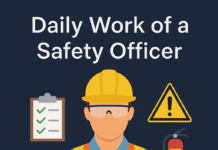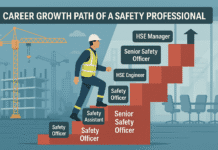
Weekly Work of a Safety Officer
Safety is not just about responding to accidents when they occur—it’s about creating systems, culture, and routines that prevent them from happening in the first place. While the daily work of a safety officer revolves around inspections, toolbox talks, and hazard identification, their weekly responsibilities go much deeper.
Weekly tasks allow safety officers to review performance, spot trends, conduct structured inspections, hold meetings, and prepare for upcoming risks. In other words, a week is the perfect timeframe to look beyond short-term fixes and focus on long-term safety improvements.
In this article, we will explore the weekly work of a safety officer in detail, breaking it down into structured responsibilities, step-by-step weekly routines, real-life case studies, and best practices.
1. Reviewing Weekly Safety Performance
At the start of every week, a safety officer’s first big responsibility is reviewing the previous week’s safety performance. This is different from daily logs because it looks at patterns, not just individual incidents.
Key elements reviewed include:
- Accidents and near-misses – How many occurred, in which department, and what were the causes?
- PPE compliance records – Were there repeated violations, and by whom?
- Permit-to-Work system checks – Were all permits issued correctly and closed properly?
- Housekeeping scores – Did different zones maintain cleanliness and orderliness?
For example, if three near-misses occurred in the scaffolding area last week, the officer highlights this as a priority focus for the coming week.
📌 Case Study: In a large oil refinery project in Saudi Arabia, weekly reviews revealed a recurring issue—workers removing face shields during welding because of discomfort. The safety officer worked with management to procure lighter, anti-fog shields, drastically reducing violations.
2. Weekly Safety Inspections
Unlike daily inspections, weekly inspections are detailed and structured. These inspections may take hours and often involve a checklist covering every safety aspect of the workplace.
A typical weekly inspection includes:
- Fire safety systems – Checking hydrants, sprinklers, extinguishers, and fire alarms.
- Scaffolding and ladders – Inspecting stability, bracing, and tagging systems.
- Hazardous materials – Verifying proper labeling, storage, and segregation.
- Emergency exits and signage – Ensuring routes are clear and illuminated.
- Heavy machinery and lifting equipment – Confirming maintenance records and safe operating practices.
These inspections are often conducted with supervisors and safety committee members so that findings are immediately discussed and corrective actions are assigned.
💡 Best Practice Tip: Rotate inspection teams weekly so that fresh eyes see the workplace. Different people often notice different hazards.
3. Conducting Weekly Safety Meetings
Every week, safety officers lead or participate in safety coordination meetings. These are more formal than daily toolbox talks and include:
- Supervisors and department heads – who share updates from their areas.
- Contractors and subcontractors – aligning safety practices across different companies.
- Worker representatives – giving a voice to ground-level employees.
The safety officer presents:
- Weekly incident statistics (accidents, near-misses, unsafe conditions).
- Findings from inspections.
- Progress on corrective and preventive actions.
- Key focus areas for the coming week.
📌 Case Study: On a metro construction project in India, weekly meetings revealed that electrical subcontractors were bypassing lockout/tagout. After escalation, management enforced stricter permit-to-work procedures, preventing a potential electrocution hazard.
4. Weekly Training and Awareness Sessions
Training is the backbone of safety. While daily toolbox talks provide quick reminders, weekly sessions dive deeper into specific safety topics.
Examples of weekly training include:
- Fire safety and extinguisher use – Practical drills with live fire training.
- Lockout/Tagout (LOTO) – Hands-on demonstration of energy isolation.
- Ergonomics – Teaching workers correct lifting techniques.
- Confined space entry – Mock rescue drills and gas monitoring practice.
These sessions last 30–60 minutes and are interactive, with quizzes, demonstrations, or role-play exercises.
💡 Tip: Always link weekly training topics to incidents or risks identified in recent inspections. This makes the training practical and relevant.
5. Reviewing Corrective and Preventive Actions (CAPA)
Throughout the week, safety officers issue corrective actions (to fix current hazards) and preventive actions (to avoid future hazards). By the end of the week, they must review the status of all open actions.
For example:
- If a scaffold was found unstable on Monday, was it fixed by Thursday?
- If a near-miss occurred due to poor housekeeping, was a new cleaning schedule implemented?
- If workers keep entering restricted areas, were new barricades or signage installed?
The safety officer updates the CAPA tracking sheet and follows up with supervisors who failed to close out assigned actions.
📌 Case Study: In a UAE construction project, weekly CAPA reviews showed repeated failures in closing excavation safety hazards. The safety officer escalated to senior management, who then introduced financial penalties for contractors failing to act. This drastically improved compliance.
6. Emergency Preparedness Drills
Emergencies don’t announce themselves—they strike suddenly. That’s why weekly emergency preparedness checks are a standard responsibility of every safety officer.
Weekly activities include:
- Testing alarms – Ensuring fire alarms, gas detectors, and sirens are working.
- Checking emergency response teams (ERTs) – Verifying if fire wardens, first aiders, and rescue teams are available and trained.
- Conducting small-scale drills – Fire evacuation walk-throughs, spill response demonstrations, or mock first-aid practice.
- Verifying emergency equipment – Fire hoses, extinguishers, stretchers, and eye wash stations.
📌 Example: On a chemical plant site, the safety officer scheduled weekly mock spill containment exercises. This improved response time from 12 minutes to under 5 minutes in just a month.
By practicing weekly, workers become more confident, and panic during real emergencies is reduced.
7. Weekly Documentation and Reporting
Safety officers prepare weekly safety reports that go to management. These reports are much more comprehensive than daily logs and usually include:
- Incident statistics – Total accidents, near-misses, and unsafe acts.
- Inspection findings – Hazard categories and compliance levels.
- Training conducted – Number of sessions, topics covered, and attendance.
- Outstanding CAPAs – Which corrective actions remain open.
- Recommendations – Areas requiring budget or managerial intervention.
These reports form the basis for management reviews and safety committee meetings. They also help track long-term safety performance.
💡 Tip: Visualize data with charts and graphs in weekly reports. For example, a bar chart showing “unsafe act observations by department” makes the issue clearer to management.
8. Contractor and Visitor Safety Reviews
Large industrial and construction projects often involve dozens of contractors. Managing their safety performance is one of the biggest weekly responsibilities of safety officers.
Each week, officers:
- Review contractor safety statistics.
- Check if subcontractors conducted toolbox talks.
- Audit contractor compliance with PPE, permits, and training requirements.
- Provide safety feedback in weekly coordination meetings.
Visitors are also included in reviews. If visitor inductions are too short or incomplete, the safety officer updates induction procedures.
📌 Case Study: On a power plant project in India, weekly contractor reviews revealed that a subcontractor consistently failed to provide fire watchers during welding. After repeated warnings, the contractor was penalized and later replaced. This strict enforcement prevented potential fire incidents.
9. Equipment and PPE Audit
Weekly checks also cover safety equipment and PPE stock. This includes:
- Ensuring PPE like helmets, gloves, earplugs, and harnesses are in good condition.
- Checking expiry dates for harnesses, self-contained breathing apparatus (SCBA), and fire extinguishers.
- Auditing first-aid kits and replacing expired medicines.
- Reviewing PPE inventory and placing orders if stocks are low.
💡 Best Practice: Maintain a PPE issue and return log. This prevents misuse, tracks accountability, and ensures workers have the right gear for their jobs.
10. Planning for the Next Week
Weekly routines are not complete without planning ahead. A safety officer prepares for upcoming risks by:
- Reviewing next week’s project schedule.
- Identifying high-risk activities (like heavy lifts, excavation, or confined space work).
- Preparing targeted toolbox talk themes.
- Assigning additional training if required.
For example, if concrete pouring for a high-rise slab is planned next week, the safety officer may plan a special session on fall protection and formwork safety.
This forward-looking approach makes safety proactive rather than reactive.
11. Weekly Routine Breakdown (Monday–Friday)
To understand the weekly cycle better, let’s break down a typical week of a safety officer:
Monday – Kickstart and Planning
- Review incidents from the previous week.
- Conduct weekly site inspection.
- Hold a short coordination meeting with supervisors.
Tuesday – Training and Inspections
- Deliver weekly training/awareness session.
- Audit scaffolds, machinery, and high-risk areas.
- Meet contractors for compliance updates.
Wednesday – Emergency Preparedness Focus
- Test fire alarms and emergency equipment.
- Conduct small-scale evacuation or spill drills.
- Check ERT readiness.
Thursday – CAPA Review and Contractor Audit
- Follow up on corrective actions.
- Audit contractor compliance.
- Document findings in weekly report draft.
Friday – Reporting and Future Planning
- Finalize weekly safety report.
- Present key findings in weekly management/safety committee meeting.
- Prepare toolbox talk topics for the next week.
This structured breakdown ensures no critical area is ignored.
12. Challenges in Weekly Work
Weekly duties are not without challenges. Common ones include:
- Closing CAPAs on time – Some supervisors delay corrective actions.
- Contractor non-compliance – Subcontractors may cut corners under pressure.
- Limited training time – Production teams often complain about “lost hours.”
- Management priorities – Budget constraints may slow safety improvements.
Strong communication, leadership, and persistence help safety officers overcome these obstacles.
13. Why Weekly Work Matters
Daily safety tasks catch immediate hazards, but weekly work focuses on safety culture, systems, and long-term improvement.
Weekly inspections ensure workplaces remain compliant. Weekly reports keep management informed. Weekly training improves worker skills. Together, these tasks create a strong, sustainable safety environment.
As the saying goes: “Safety is not built in a day—it is built daily and reviewed weekly.”
Conclusion
The weekly work of a safety officer is about looking beyond today and planning for tomorrow. From structured inspections and training to contractor audits and emergency drills, every weekly activity strengthens workplace safety.
By combining daily routines with weekly reviews, safety officers create a powerful safety management cycle that reduces risks, improves compliance, and saves lives.
For additional resources, visit the UK HSE official guidance on managing health and safety.
Daily Work of a Safety Officer
Career Growth Path of a Safety Professional (From Fresher to HSE Manager)
Safety Officer Salary in India and Abroad 2025 (Updated)
Top 10 Safety Courses for a Successful Career in HSE
How to Become a Safety Officer After Graduation?
FAQs
1. What’s the difference between daily and weekly safety officer work?
Daily work focuses on immediate hazards, while weekly work addresses trends, systems, and future planning.
2. Do safety officers always conduct weekly drills?
Yes, at least small-scale drills are often conducted to maintain preparedness.
3. Why are weekly reports important?
They highlight trends and provide management with clear insights into safety performance.
4. Do weekly inspections involve contractors?
Yes, contractors are audited weekly to ensure compliance with site rules.
5. How do safety officers plan for upcoming risks?
By reviewing project schedules, identifying high-risk jobs, and preparing targeted safety measures.
























